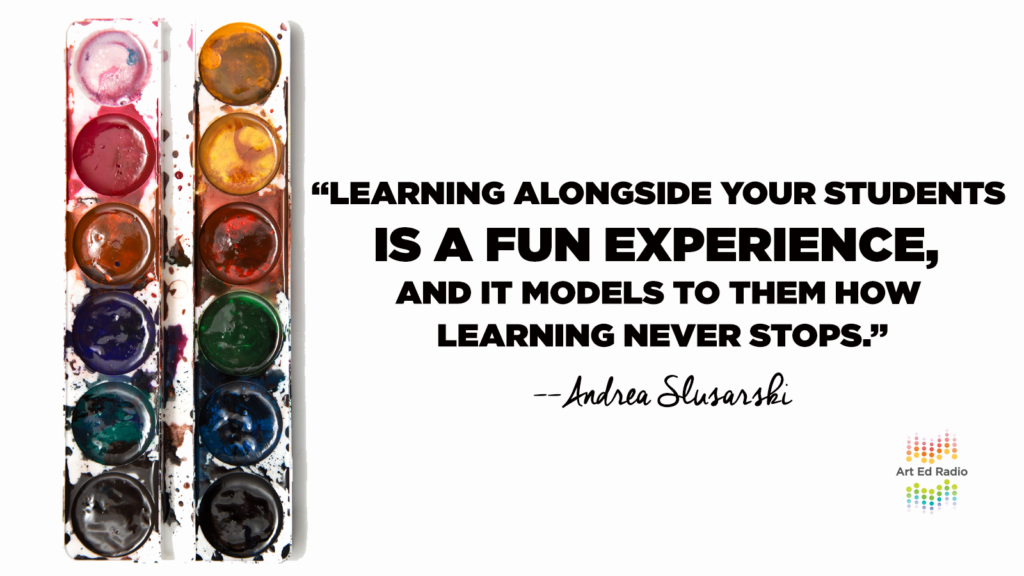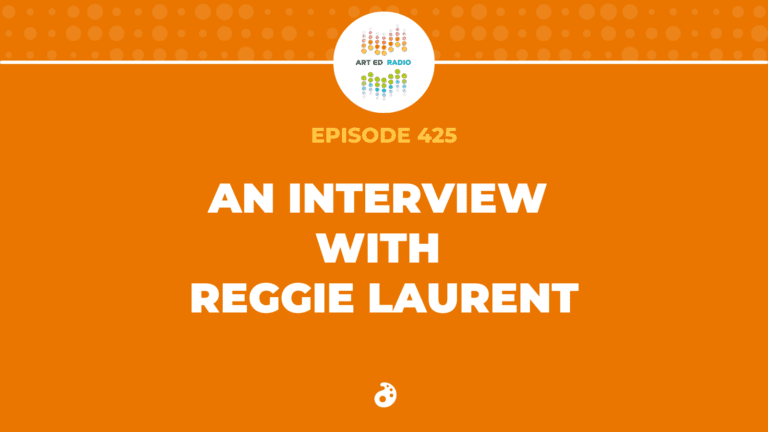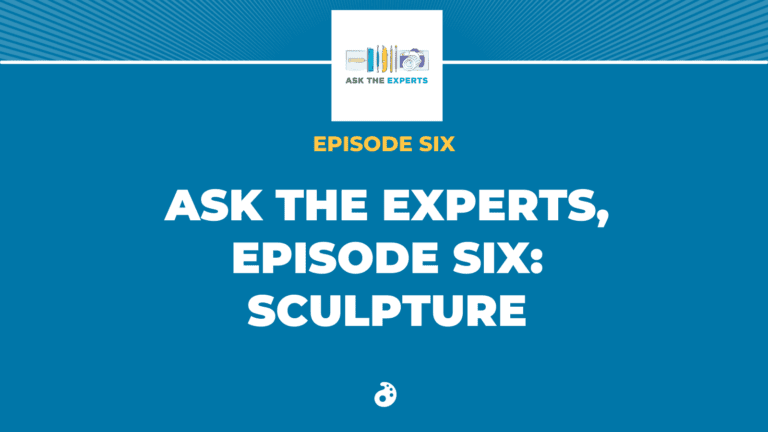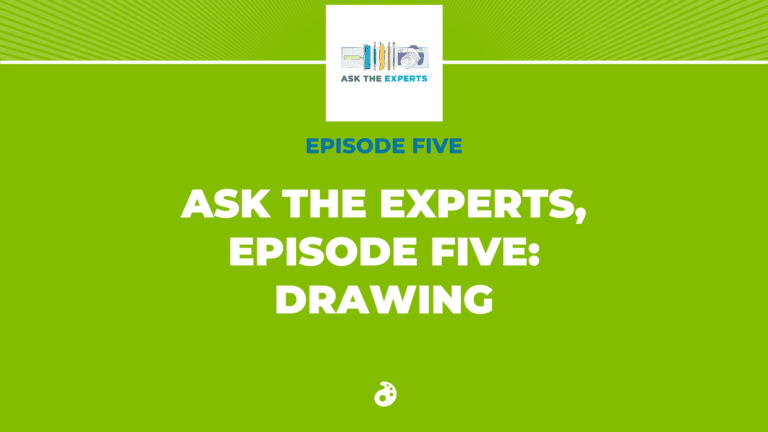After talking with Abby Schukei last month about teaching content when you struggle, Tim is inspired to learn more about watercolor. He turns to Andrea Slusarski, plein air painter extraordinaire, to find some tips and tricks to improve his teaching with the medium. Tim goes on a rant about his dislike for watercolors (5:00), Andrea shares some of her best strategies for teaching watercolor (10:15), and how to build confidence in your students when they are developing new skills (17:15). Full episode transcript below.
Resources and Links
- Andrea’s Watercolor Night Skies
- Exploring Color Theory Through Watercolor
- Cassie Stephens’ Podcast on Watercolor
- An Engaging Watercolor Lesson for All Ages

Transcript
Welcome to Art Ed Radio, the podcast for art teachers. This show is produced by The Art of Education, and I’m your host, Tim Bogatz.
We all have that medium that we don’t love or maybe we’re not quite comfortable enough with, and, for me, it’s watercolor. Watercolor is a paint that I find a little bit intimidating, and I’m trying to get over that. I’m trying to learn to love it, but I just can’t do it, and I’m really not sure why. I’ve been the most experimental with watercolor, more so than any other paint I’ve worked with, and I always want my students to experiment with materials, and watercolor really fits that bill. It’s a great medium for kids to explore, and it should be something that they love, as well, but here’s the problem. Nobody loves it. My kids never love working with it, and I’ve never loved teaching it. That begs the question. Do my kids not like it because they’re following my lead, or is this just a medium that nobody likes to deal with?
My other question for all of the art teachers out there, is there anyone out there who actually enjoys teaching watercolor? I’m sure there are, obviously, but I definitely don’t know them. Everyone that I talk to begrudgingly breaks out the medium because they feel like they have to, but no one is embracing it, and no one has a great system for what to teach and how to go about it.
Today, I want to figure this out. I’m asking for help. Andrea Slusarski is back on the show, and she’s going to try to convince me that I need to love watercolor and that I can love watercolor. I think that’s going to be a tough lift for her, but we’ll see what she can do.
Fan favorite, Andrea Slusarski, is here once again. Andrea, how are you?
Andrea: Fan favorite? Cool.
Tim: Just any time you come on the show, I get lots of emails, like, “Who is this girl? She’s awesome,” or people have heard you before who are like, “Oh, yes. I love it when she’s on. You need to have her on more.” I think you get the title of fan favorite.
Andrea: Aw, sweet. Well, thank you. I’m doing great. I’m excited to chat tonight.
Tim: I wanted to have you on because I need your help with someone. I’m trying to learn to love watercolor. I’m honestly really trying, but I just can’t get there. I know you love it. I’m hoping you can help me. Let’s start with this. What do you love about watercolor?
Andrea: What do I love? I want to just put a disclaimer out there. There are some times when I’m super frustrated with watercolor, as well. That’s watercolors, but what I love is how it challenges me, and it puts me in a perspective at the same time, and I think that has come out of those challenges because I’m a pretty busy girl. I always have been. It’s just my norm. A lot of people probably don’t … Maybe, if you knew me, it makes a lot of sense, but if you’re thinking that I’m just art teacher crazy, I’m incredibly type A, and I scare and impress myself with my organizational skills sometimes.
Andrea: I’m crazy, but watercolors are like, “Oh, the heck with that. We’re gonna do what we want,” and to paint and engage with watercolors, to me, is this immediate feeling of letting go and just engaging in the painting process, especially with my sketchbooks. The medium brings me to the moment and present where I’m creating, and so I really value that. Watercolor, however, is not my only medium. I rather enjoy acrylic painting and just a good old pencil/pen illustration, but the watercolors and the sketchbook has evolved out of my effort to engage in my art making more in my life, and they’re easier to pack up and incorporate, even on those busier days.
Tim: I can see this. Can I offer my counterpoint, though?
Andrea: Yes. Yes.
Tim: As romantic as you make this all sound, working with watercolors is still terrible. Can I share with you some of my frustrations with watercolors?
Andrea: I love this question, and I’m sure I’ve heard all of them before, and I’m going to save my art teacher pep talk, but I want to know. I want to hear them. Light them up. Get it all out.
Tim: I may need to hear the pep talk. Let me just say that, as we’ve established, watercolors are the worst. Well, actually, actually, scratch that. Let me put it this way. Watercolors are not the best for anything. They’re always my second or third choice, no matter what I’m doing. If I’m working big, I want to do that with acrylic. If I’m doing a portrait, I want to work with oils or pastels. If I’m working in my sketchbook, I want to use pencil, I want to use pen, maybe some markers even, and if I do use watercolor there, then it’s just going to mess up my paper and fold it up, and it’s a giant mess.
Andrea: The paper’s wrinkly, and it won’t shut nice and neat.
Tim: Exactly. Going back to your type A thing right there. I guess any time I’m working with watercolor, I’m frustrated because, no matter what I’m doing, I’m always thinking to myself, there’s always that voice in the back of my head going, “This other material would be so much better for this. Why are you choosing watercolor?” Am I way off base there?
Andrea: No. I think that just comes from, number one, you being a skilled artist and knowing where your mediums are at. I would agree with you. Watercolor is extremely challenging. One of the things about watercolor, and I talk about this a lot in my class because we’re currently doing watercolors, and it’s the same thing. There’s my half of my class that’s like, “This is the coolest thing I’ve done all year,” and there’s the other half of my class who is begging me to get the acrylic paints back out. Literally, I have this one boy come in every day and is like, “Can I be done?” I just try to pump him up so hard, and I know I’m going to get maybe a couple more days, and then I’m just going to be like, “Yeah, you can do a different painting. You really gave it a shot.”
Tim: You can only make him suffer for so long.
Andrea: I can only make that. I don’t know. I guess where I come into, and I’m only talking from my experience, so I can persuade you on the watercolor train is it’s more about the feeling for me, and if you look at a lot of my work, a lot of my control and detail is done with pen and pencil, so I sometimes feel like I’m more of an illustrator who just enjoys watercolors, not technically a watercolor artist, if that makes sense.
Tim: That makes a lot of sense.
Andrea: It’s just been a way for me to, like I said, be a little bit looser in my work because my drawing and my pen work is super detailed. It’s this challenging myself and incorporating these different areas of art into my work. Like I said, watercolor, yesterday, I was in my studio, and I was not having it. I think it’s just important to know with whatever art making you’re doing, we got to focus on what we tell our students because I hear my teacher self, and they are like, and Miss Slu is like, “You need to slow down and get a scrap piece of paper and practice,” or, “You need to rethink this or take a break.”
Andrea: I don’t know. Watercolor’s hard, and I love your rant.
Tim: Basically, it just comes down to I need to suck it up, and if I really want to learn this, then I just need to deal with my frustrations because that’s part of it?
Andrea: I think maybe not a suck it up, but maybe just engage more in the watercolor process and not try to compare it to something else.
Tim: Oh, that’s good. That’s good.
Andrea: Then, in that way, you can really see how you engage with the medium.
Tim: I want to dive into that a little bit more. Abby Schukei was on a little while back, and she and I talked about what do you do when you’re not comfortable with content. In that case, it was when you have to teach something that you’re not comfortable with. For me, that’s watercolor a lot of times, and if you think teachers are wanting to learn more about watercolor or they’re in my situation or they’re just interested in working with it more or teaching it better, where should they go? I guess, more specifically, if we really dive in, what kind of techniques or ideas or strategies should people be focusing on?
Andrea: First, and I already highlighted this in the last question, so I’ll go quickly. It’s just give yourself a break. You’re an awesome artist, and you’re an awesome teacher for a reason. That’s everyone listening to this podcast, everyone hear that, and follow your own advice that you would in the classroom. We are our best teachers when we can also be students, and, luckily, AOE has a few awesome online courses that will break a ton of techniques and projects specific to watercolor by me. I filmed those last summer. It was cool, which have been making me look like quite the cool daughter to my parents, by the way, and now you’re thinking that I’m a fan favorite. They’re going to be telling all their friends how much of an art teacher celebrity I am.
Tim: They are so proud of you. That’s awesome.
Andrea: It’s so cute, but, seriously, I recommend those because when we built and filmed them, we really focused on getting the most direct instruction and specifics that art teachers want to hear because I’m an art teacher, and I don’t want any BS so I wasn’t going to say any BS-
Tim Bogatz: Yes.
Andrea: Because nothing’s more annoying than listening to crappy YouTube videos over and over and over until you find the ones that actually will somewhat be useful in your classroom sometimes.
Tim: Yes, well, if I can just interrupt, that’s what I love about AOE courses because I’ve been a part of designing a bunch of those studio courses, and it’s just amazing that we can just sit there and focus on what do art teachers want to know and then design the course around it. It is. It’s an awesome experience to be part of that, but, anyway, go on. Go on.
Andrea: It was really fun to write that when I had that opportunity to think how an art teacher would learn, as well, which was really neat, but if you’re really dreading … Moving on. If you’re really dreading watercolor … I know. Sorry. I’ve had a couple cups of coffee tonight, but you know you definitely have to include it in your classroom. First, I just want to thank you for making that decision to learn and grow as a teacher. Second, connect it to something that you’re really good at. This way, you can still feel confident as you explore new territory or say, “The heck with it,” and let your students know that you’re also learning because learning alongside your students is a fun experience and models to them how learning never stops.
Tim: That’s really good advice. I like that idea because I think it really reduces the barrier to entry if you can make it part of a mixed medium piece or if, like you said, making it more of an illustration where watercolor’s just a part of a bigger whole.
Andrea: Exactly, find your strength so that you have some comfortable part to it.
Tim: That makes sense, but I also wanted to ask you … Another thing that Abby and I were joking about in that episode, but I think is probably worth exploring here is the direction you go when you’re teaching watercolor because everybody does the same 12 exercises. We’re going to have a wash in this box and then wet on wet in this box and then we’ll do a resist, and then if you get real fancy, we’re going to sprinkle some salt and see what that effect is, but the big question is, then what? We’ve done these 12 squares with all the different watercolor techniques, but where do you go from there?
I guess I want to ask you about your classroom. What kind of lessons do you teach? Do you incorporate those exercises and bring them into actual painting or actual work?
Andrea: This is probably going to be a lot because I’m currently teaching my watercolor unit, and I do save it for this time of the year because we go outside when it’s a nice day out, and watercolors, they’re taped out on the boards where it … We like to go outside. It’s fun. It’s what we do. Since I’m all about reps and experimentation, I trick my students into building up all of their watercolor skills, and it’s hard for me to fully describe, but I’ll discuss what a typical watercolor unit looks like in my classroom.
We start with those techniques, the boring … Here’s a box. Here’s your techniques, but I don’t care. You have two days to explore with washes, wet to wet, dry brush, resist. You know the watercolor drill. I don’t care if they’re in the boxes. I don’t care what colors you use. I just want you playing around, and I’ll demo those techniques, and then they give them a shot, but most importantly, I’m walking around and constantly monitoring my students in the amount of water they’re using. I’m not even looking at the techniques yet. We’re not there. They think they are. This is hurdle number one. I have my students pouring water all over the table, and then I have some students conserving it like it’s the last cup of water they’re ever going to paint with, which is bad when your watercolor’s big and thick and gunky and it’s not working. I love that. “Miss Slu, my watercolors are broke,” and I’m like, “Hmm, thank you for that.”
Finding that consistency and control with the water and the pigment is what I’m most focused on during those demo explore couple of days because the techniques we’re going to build and we’re going to refer to, because this isn’t the first time we’re going to use them, because when I work them into projects, and I bring in some smaller, fun projects … This year, we did galaxy skies and crystal paintings. I cut a crap ton of six by nine papers and tell students to have at it because I find that with watercolors, students work at such different paces, and I open this project up for kids to paint as many or as little paintings in our timeframe.
All throughout that, I’m talking about the techniques that we talked about at the beginning of the week, but people didn’t really listen to me to begin with because it’s boring. I know that, but then I repeat it. We’re doing our galaxy sky, and the first stroke that you need to do is a wet into wet stroke, and then we’re going to let that dry, and then we’re going to use the dry brush here. It’s the reps, I tell you. It’s the reps and showing how they can take those techniques and obtain them into different parts of their paintings because a watercolor painting uses all the techniques. You can’t just do one of them.
Tim: I think that’s good to give kids a little bit of context as far as which techniques can go where, and I think that’s something that a lot of teachers are looking for, but I want to ask you something else. You say you’re cutting all of these little, tiny papers and just letting kids go with that. Do you care what they’re painting there? Are they doing still lifes or landscapes or portraits or anything in particular, or is this just a time where kids are experimenting and exploring and, like you said, getting those reps in?
Andrea: It’s a little bit of both. With the smaller projects, I do focus them, like I said, with the galaxy sky or the crystal painting or we’ve done cool zentangle exercises, and the purpose of these, and the reason why I have a direction is because I want students to feel confident. Have you ever painted a watercolor night sky, Tim?
Tim: I have not.
Andrea: You need to come to my studio, and we’re going to paint that, and then you’re going to think that you are the coolest watercolor painter in the whole world.
Tim: All right. That sounds like a deal.
Andrea: That takes a little bit of the watercolor frustration away because you just made a cool galaxy, and you got to splatter paint some stars and make a big, old mess, and that was all you had to do today in painting, and it’s fun. I give them some direction. I do collect a formative grade, so I will give them a timeframe. We have the next four days in class to work on these different types of paintings. You choose your own adventure because they all have the techniques I want them to practice, and then they feel like they have a little bit of freedom, and then they work on those, and I’m like, “Pick your favorite two and turn those into me,” and that’s what I’m going to grade.
Tim: That’s really cool. I think that choice and that exploration is huge when kids are trying to learn, but I guess one last question for you. With watercolor leading to so much frustration, even when you are painting amazing night skies and all of that cool stuff, how do you make it fun? How do you make it enjoyable for the kids? Do you have an example of something you’re doing to make painting with watercolors more fun for your kids?
Andrea: Yeah. This year, I wanted to add more to my landscapes because the same thing happened in previous years. I had half of my class super into it. The other half did it in a day, and they were over it. I wanted to spice it up a little bit, and I created landscape element days. Each day, this is a … We’re currently towards the end of our project, and it’s been really fun. I demoed and discussed how to create various elements of landscapes using watercolors. We did clouds, trees, plants, grasses, rocks, and, yes, I put every Bob Ross quote that I possibly could into every single demo. I was like, “I have some quotes for you guys.”
Then, that helped. I turned it into a contest. It’s the end of the year. Can we blame kids for having a little ants in their pants and wanting to be outside and not be frustrated? I don’t. We are actually doing a Bob Ross original painting, and the trick here is, can you accurately draw and paint an original Bob Ross painting using watercolor.
Tim: I love this. I love this.
Andrea: All of the kids are super into it. The winners get their very own Bob Ross official socks, and the competition is hot in my classroom.
Tim: I can imagine. I don’t want to interrupt, but I’m going to anyway. Have you played the Bob Ross board game, The Art of Chill Game?
Andrea: Yes.
Tim: Okay, good.
Andrea: I got it for Christmas, and we play it all the time.
Tim: I think it’s cool that’s part of your classroom because I think it’s vital to-
Andrea: It’s so fun.
Tim: …a good understanding of Bob Ross, but, anyway, go on. I need to hear about-
Andrea: My kids are arguing over they don’t have enough titanium white resources on a board game, I’m a happy art teacher. The cool thing about this project is we did all those elements in fun, little demo days. Here’s a bunch of clouds. Here’s a bunch of these. Because we practiced our techniques again, they know how to mix those colors and values and techniques because I showed them. We talked about our colors together, and we practiced them all individually, so their final work is just being able to piece all of those individual demos together into one painting, which has been a really fun conversation because kids pick their either Bob Ross originals, so now we’re Googling Bob Ross originals for a day, and we’re talking about, “Well, how do you think you’re gonna paint these clouds? How do you think you’re gonna paint these trees? Why is that gonna be different than the background?”
All meanwhile, we’re using landscape techniques, they’re building these up, but there isn’t that fear of having to make this perfect landscape because Bob Ross already painted that for them, and they’re just focusing on the colors and the watercoloring because that’s hard enough.
Tim: If they do it well enough, they’re going to end up with some Bob Ross socks, so it doesn’t get any better than that.
Andrea: Yeah, and they get Bob Ross socks.
Tim: Wow.
Andrea: It’s pretty cool. One of them has got a bunch of pine trees, and so there’s happy, little trees everywhere.
Tim: I love it. I love it. I want to enter this contest, but I know I’m probably disqualified, but that’s okay. I think that is a great place to leave it. Slu, thank you so much. It’s always awesome to talk to you.
Andrea: Thank you.
Tim: We’ll have to have you back on again soon.
Andrea: I can’t wait.
Tim: As Andrea mentioned, there are a lot of great opportunities for you to improve your watercolor skills. First, AOE has a studio painting watercolor course. You can learn more about watercolor while creating your own art and finding new ideas for your classroom and would be perfect for somebody in my situation right now. If the podcast and this 20-minute discussion isn’t enough for you, you really want to dive deep, it’s a really good opportunity.
We also have two great Art Ed PRO Learning Packs. One is called Getting Started with Watercolor Painting. The second is called Exploring Color Theory Through Watercolor. Guess who’s the facilitator for both of those PRO Learning Packs? The one and only Andrea Slusarski.
You can find more information about AOE’s courses and Art Ed PRO at theartofed.com.
I like a couple things that she said. First, she’s not necessarily a watercolor artist. She’s an artist who happens to work with watercolor, and I think that’s a good approach. You can look at it as one of the tools you have, just one of your options. You don’t have to master the medium, but you do need to be able to do it. There’s always the option, as she discussed, to connect it to something that you’re better with.
That leads me to the second idea that I want to emphasize from today. She said that you just need to engage with the medium and not compare it to anything else, and that makes me a little sad because she really shut down my rant and the point that I was trying to make, but she’s right. You need to get through your techniques and then let your kids go, explore, experiment, play, and let kids put it together in the way that they feel most comfortable and the way that they enjoy and the way that gives them confidence. They might actually love it, and you, in turn, might actually come to enjoy teaching watercolor.
Art Ed Radio is produced by The Art of Education with audio engineering from Michael Crocker. As always, I’d love you to sign up for our email list. It has been going crazy every week with more and more people adding, so I feel like I just need to keep talking about it. Make sure that you sign up at artedradio.com, get some cool emails about the episode each and every week, and while you’re at artedradio.com, you can check out all of our old episodes and a lot of other great content. Thank you, as always, for listening, and we will talk to you next week.
Magazine articles and podcasts are opinions of professional education contributors and do not necessarily represent the position of the Art of Education University (AOEU) or its academic offerings. Contributors use terms in the way they are most often talked about in the scope of their educational experiences.



